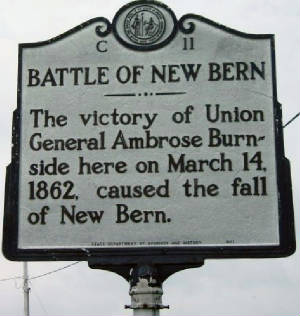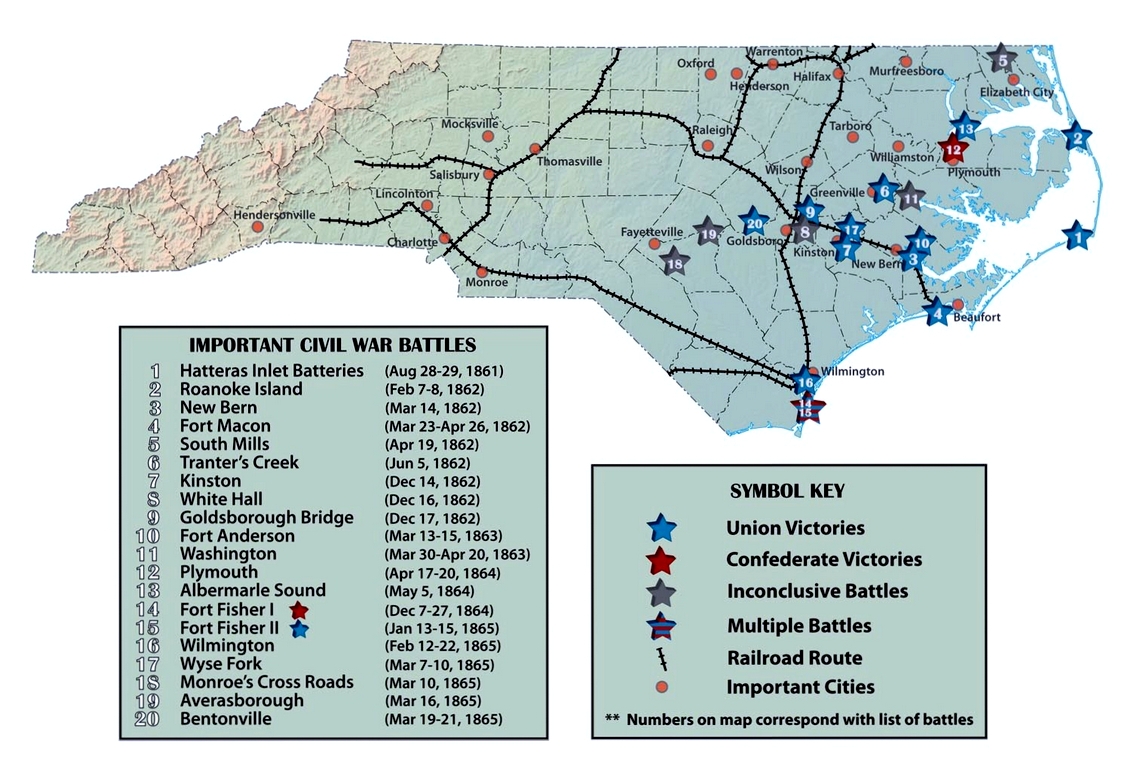|
Battle of New Bern
Other Names: New Berne
Location: Craven County
Campaign: Burnside's North Carolina Expedition (February-June 1862)
Date(s): March 14, 1862
Principal Commanders: Brig. Gen. Ambrose E. Burnside [US]; Brig.
Gen. Lawrence O’B. Branch [CS]
Forces Engaged: Expeditionary Force and Foster’s, Reno’s,
and Parke’s Brigades [US]; 5 regiments, militia [CS]
| Civil War Battle of New Bern, NC |

|
| New Bern Civil War Historical Marker |
Estimated Casualties: 1,080 total
Result(s): Union victory
Description: On March 11, Brig. Gen. Ambrose E. Burnside’s
command embarked from Roanoke Island to rendezvous with Union gunboats at Hatteras Inlet for an expedition against New Bern.
On March 13, the fleet sailed up the Neuse River and disembarked infantry
on the river’s south bank to approach the New Bern defenses. The Confederate defense was commanded by Brig. Gen. Lawrence
Branch.
On March 14, John G. Foster’s, Jesse Reno’s, and John G.
Parke’s brigades attacked along the railroad and after four hours of fighting drove the Confederates out of their fortifications.
The Federals captured nine forts and 41 heavy guns and occupied a base which they would hold to the end of the war, in spite
of several Confederate attempts to recover the town. The capture
of New Bern reflected another accomplishment towards the
fulfillment of General Winfield Scott's "Anaconda Plan." (See Battle of New Bern: Detailed History)
| Battle of New Bern |

|
| North Carolina Civil War Battlefields Map |
| Battle of New Bern Map |

|
| Civil War Battle of New Bern |
Source: National Park Service
Recommended Reading: The
Civil War on the Outer Banks: A History of the Late Rebellion Along the Coast of North Carolina from Carteret to Currituck
With Comments on Prewar Conditions and an Account of (251 pages). Description: The ports at Beaufort, Wilmington, New Bern and Ocracoke, part of the Outer Banks (a chain
of barrier islands that sweeps down the North Carolina coast from the Virginia Capes to Oregon Inlet), were strategically
vital for the import of war materiel and the export of cash producing crops. From official records, contemporary newspaper
accounts, personal journals of the soldiers, and many unpublished manuscripts and memoirs, this
is a full accounting of the Civil War along the North Carolina
coast.
Recommended Reading: The Civil War in the Carolinas
(Hardcover). Description: Dan Morrill relates the experience
of two quite different states bound together in the defense of the Confederacy, using letters, diaries, memoirs, and reports.
He shows how the innovative operations of the Union army and navy along the coast and
in the bays and rivers of the Carolinas affected the general course of the war as well as
the daily lives of all Carolinians. He demonstrates the "total war" for North
Carolina's vital coastal railroads and ports. In the latter part of the war, he describes
how Sherman's operation cut out the heart of the last stronghold
of the South. Continued below...
The author
offers fascinating sketches of major and minor personalities, including the new president and state governors, Generals Lee,
Beauregard, Pickett, Sherman, D.H. Hill, and Joseph E. Johnston. Rebels and abolitionists, pacifists and unionists, slaves
and freed men and women, all influential, all placed in their context with clear-eyed precision. If he were wielding a needle
instead of a pen, his tapestry would offer us a complete picture of a people at war. Midwest Book Review: The Civil War in the Carolinas by civil war expert and historian
Dan Morrill (History Department, University of North Carolina at Charlotte, and Director of the Charlotte-Mecklenburg Historical
Society) is a dramatically presented and extensively researched survey and analysis of the impact the American Civil War had
upon the states of North Carolina and South Carolina, and the people who called these states their home. A meticulous, scholarly,
and thoroughly engaging examination of the details of history and the sweeping change that the war wrought for everyone, The
Civil War In The Carolinas is a welcome and informative addition to American Civil War Studies reference collections.
Recommended Reading: Storm
over Carolina: The Confederate Navy's Struggle for Eastern North Carolina. Description: The struggle for control of the eastern
waters of North Carolina during the War Between the States
was a bitter, painful, and sometimes humiliating one for the Confederate navy. No better example exists of the classic adage,
"Too little, too late." Burdened by the lack of adequate warships, construction facilities, and even ammunition, the
South's naval arm fought bravely and even recklessly to stem the tide of the Federal invasion of North
Carolina from the raging Atlantic. Storm
Over Carolina is the account of the Southern navy's struggle in North
Carolina waters and it is a saga of crushing defeats interspersed with moments of brilliant and even
spectacular victories. It is also the story of dogged Southern determination and incredible perseverance in the face
of overwhelming odds. Continued below...
For most of
the Civil War, the navigable portions of the Roanoke, Tar, Neuse, Chowan, and Pasquotank rivers were
occupied by Federal forces. The Albemarle and Pamlico sounds, as well as most of the coastal towns and counties, were also
under Union control. With the building of the river ironclads, the Confederate navy at last could strike a telling blow against
the invaders, but they were slowly overtaken by events elsewhere. With the war grinding to a close, the last Confederate vessel
in North Carolina waters was destroyed. William T. Sherman
was approaching from the south, Wilmington was lost, and the
Confederacy reeled as if from a mortal blow. For the Confederate navy, and even more so for the besieged citizens of eastern
North Carolina, these were stormy days indeed. Storm Over Carolina describes their story, their struggle, their history.
Recommended Reading: Ironclads and Columbiads: The Coast (The Civil War in North Carolina)
(456 pages). Description: Ironclads and Columbiads
covers some of the most important battles and campaigns in the state. In January 1862, Union forces began in earnest to occupy
crucial points on the North Carolina coast. Within six months,
Union army and naval forces effectively controlled coastal North Carolina from the Virginia line south to present-day Morehead
City. Union setbacks in Virginia, however, led to the withdrawal of many
federal soldiers from North Carolina, leaving only enough Union troops to hold a few coastal strongholds—the vital ports
and railroad junctions. The South during the Civil War, moreover, hotly contested the North’s ability to maintain its
grip on these key coastal strongholds.
Recommended Reading: Lifeline of the Confederacy: Blockade Running During the Civil War (Studies in Maritime History Series). From Library Journal: From the profusion of books
about Confederate blockade running, this one will stand out for a long time as the most complete and exhaustively researched.
Though not unaware of the romantic aspects of his subject, Wise sets out to provide a detailed study, giving particular attention
to the blockade runners' effects on the Confederate war effort. It was, he finds, tapping hitherto unused sources, absolutely
essential, affording the South a virtual lifeline of military necessities until the war's last days. This book covers it all:
from cargoes to ship outfitting, from individuals and companies to financing at both ends. An indispensable addition to Civil
War literature.
|

